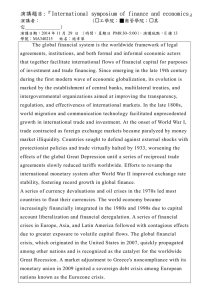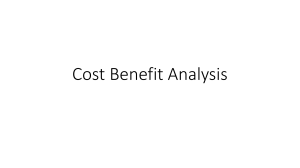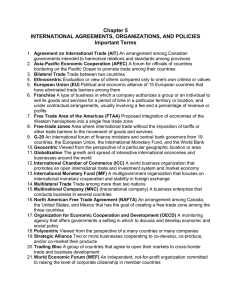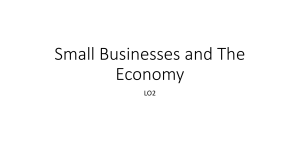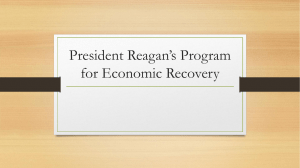Economics 244 Module Outline: Monetary & International Finance
advertisement
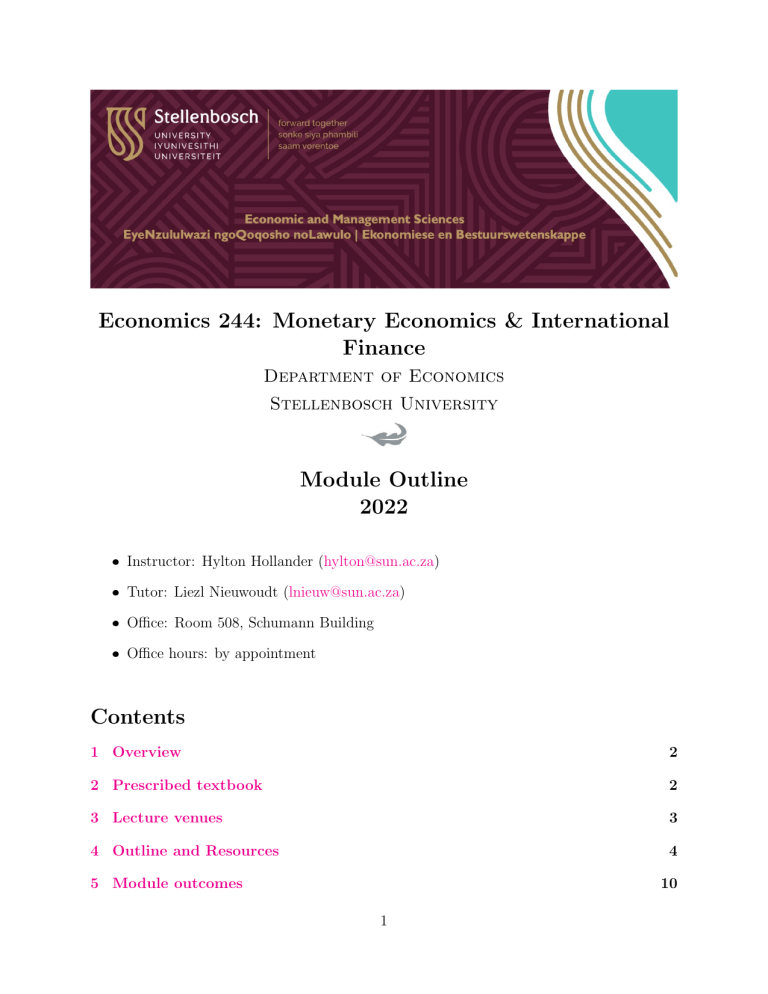
Economics 244: Monetary Economics & International Finance Department of Economics Stellenbosch University Module Outline 2022 Instructor: Hylton Hollander (hylton@sun.ac.za) Tutor: Liezl Nieuwoudt (lnieuw@sun.ac.za) Office: Room 508, Schumann Building Office hours: by appointment Contents 1 Overview 2 2 Prescribed textbook 2 3 Lecture venues 3 4 Outline and Resources 4 5 Module outcomes 10 1 1 Overview In this course on Monetary Economics and International Finance we will study the basic theory, the major issues, and the institutional and practical aspects of money and international macroeconomics. The theoretical and practical aspects of money and central banking are the focus of the Monetary Economics component. The balance-of-payments accounts, the foreign exchange market, and international capital mobility form the core of the International Finance component. Within the context we will be able to discuss policy issues related to excessive global trade and financial imbalances, international financial crises, exchange rate regimes, and the evolving international monetary system. Having completed the module successfully, the diligent student should have the necessary background and tools to understand and analyse the role of money, interest rates, exchange rates, and the balance of payments in an open economy, and have a working knowledge of monetary and financial institutions and the major international financial events and issues of the recent past. More importantly, you should be able to (re)assess conventional wisdom, appraise heterodox ideas, and filter real-time news about the global economy and the position of our country therein. 2 Prescribed textbook The Economics of Money, Banking, and Financial Markets, Global (12th or 13th ) Edi- tion by Frederic Mishkin. Available at: SU library eBook (simultaneous access may be limited) or short loan from SU library or purchase/rent eBook. – Introduction (Part 1), Chapters 1 & 2: The Motivation to Study Money, Banking, and Financial Markets and an Overview of the Financial System – Financial Institutions (Part 3), Chapters 12 & 13: Financial Crises in Advanced and Emerging Economies – Central Banking and the Conduct of Monetary Policy (Part 4), Chapters 3, 14, & 15: Money, Central Banks, and the Money Supply Process. 2 – Central Banking and the Conduct of Monetary Policy (Part 4), Chapters 16 & 17: The Tools and Conduct of Monetary Policy – International Finance and Monetary Policy (Part 5), Chapters 18 & 19: The Foreign Exchange Market and the International Financial System – Monetary Theory (Part 6), Chapter 20: the Quantity Theory, Inflation, and the Demand for Money (preliminary, depending on time) Additional accessible textbook (not prescribed): – Appleyard, D.R. and Field, A.J., 2014. International Economics, 8th ed. McgrawHill. Available at: SU library 3 Lecture venues Lectures will be presented on the following days and times. Please check SUNLearn for further changes regarding the mode of lectures (in-person or online). Below, in the final column, is the default mode of lectures. Group Day 1 Monday Tuesday Thursday 2 Time Venue 15:00 Maths/Ind Psyc 1005 12:00 Maths/Ind Psyc 1005 14:00 Maths/Ind Psyc 1005 Tuesday 09:00 Maths/Ind Psyc 1005 Wednesday 11:00 Maths/Ind Psyc 1005 Friday 12:00 Maths/Ind Psyc 1005 Tutorial times and venues: Language Afrikaans English English Day Time Venue Tuesday 13:00 Vd Sterr 1031 Thursday 13:00 Vd Sterr 1031 Friday 14:00 Vd Sterr 1031 3 4 Outline and Resources 4.1 Introduction to Money, Banking, and Finance In this section, we motivate why we should take special attention to money, banking, and financial markets — not only because it matters for you personally in planning your life but also because modern economies critically depend on the efficient functioning of the monetary and financial system. As such, we will need an overview of the general structure and operation of the major financial intermediaries and the instruments that are traded in financial markets, as well as how these markets are regulated. Resources Mishkin, Chapter 1, “Why Study Money, Banking, and Financial Markets?” and Chapter 2, “An Overview of the Financial System”1 4.2 Financial Crises in Advanced Economies & Emerging Markets Before the 2007−2008 global financial crisis and the subsequent Eurozone debt crisis, the most prominent examples of severe financial crisis in recent times came from developing countries and emerging market economies. Such economies were especially vulnerable to financial turmoil as they opened their markets to the outside world and, in particular, to international capital flows in the 1990s with hopes of rapid economic growth and reduced poverty. Most dramatic were the Mexican crisis that began in 1994, the East Asian crisis that began in July 1997, and the Argentine crisis, which started in 2001. These events presented a puzzle for economists−how can a developing country shift so dramatically from a path of high growth to such a sharp decline in economic activity, as did Mexico and particularly the East Asian countries of Thailand, Malaysia, Indonesia, the Philippines, and South Korea? 1 Note: this course assumes some basic knowledge about asymmetric information (moral hazard and adverse selection). Edited slides on Chapter 8 will be uploaded providing you with content (you do not need to read chapter 8). Your first quiz and tutorial will also include questions on asymmetric information to test your understanding. 4 In this section, we apply the asymmetric information theory of financial crises to investigate the cause of frequent and devastating financial crises in emerging market economies. We explore the dynamics of financial crises in emerging market economies. Then we summarize the government policies that reduce the likelihood of financial crises in emerging market countries.2 This section forms the overarching real-world context and motivation for the course. Resources Mishkin, Chapter 12, “Financial Crises in Advanced Economies” and Chapter 13, “Financial Crises in Emerging Markets” Additional readers (non-prescribed): – Short articles on policy spillovers, cross-border capital flows, and currency crises: Aizenman et al. (2015); Reinhardt et al. (2014); Vesperoni et al. (2014); Aizenman et al. (2014); Brunnermeier et al. (2012); Allen et al. (2011) – Kaminsky, G.L., Reinhart, C.M., and Végh, C.A. (2003) “The unholy trinity of financial contagion”, Journal of Economic Perspectives, Vol 17, Number 4, pp 51-74 4.3 Central Banks and the Money Supply Process “Money” can take many different forms and it has always been an important part of modern, and even ancient, economies. To understand the effects of money on the economy, we must first develop precise definitions of money in terms of its main functions, and we look at why and how it promotes economic efficiency. As a result, what is considered as money has evolved over time which influences how we measure it and how we understand central banking. 2 For a re-fresher on the asymmetric information framework (moral hazard, adverse selection, and the principal-agent problem) see edited Chapter 8 slides, together with Chapters 1 and 2. Chapter 8 is not prescribed, however. 5 Notably, central banks, who conduct monetary policy on behalf of governments across the world, are among the most important players in financial markets. Their policy actions affect interest rates, the amount of credit available, and the money supply, all of which have far reaching effects on economic activity. To understand the role that central banks play in financial markets and the overall economy, especially aggregate output and inflation, we need to understand how these organizations work. We will look to answer several questions such as: Who controls central banks and determines their actions? What motivates their behaviour? Who holds the reins of power? Who controls the money supply? What causes it to change? How might control of it be improved? Resources Mishkin, Chapters 3, 14, & 15: “Money, Central Banks, and the Money Supply Pro- cess” 4.4 The Tools and Conduct of Monetary Policy Getting monetary policy right is crucial to the long run stability of any economy. On the one hand, monetary policy that is too expansionary typically leads to high inflation and therefore greater inefficiencies in market economies which hamper growth and development. On the other hand, monetary policy that is too contractionary typically leads to recessions in which output falls and unemployment rises. Monetary policy can also be especially damaging to an economy because it promotes financial instability and can worsen financial crises (due to both excessive inflationary and deflationary episodes). In this section, we first examine the common tools of monetary policy used by central banks to control the money supply and interest rates (positive analysis). We then consider how central banks should conduct monetary policy (normative analysis). To explore this subject, we start by looking at the goals of monetary policy and then examine one of the most important strategies for the conduct of monetary policy, inflation targeting. We then discuss tactics−that is, the choice and setting of the monetary policy instrument. 6 Resources Mishkin, Chapters 16 & 17: the tools and conduct of Monetary Policy 4.5 The Foreign Exchange Market The exchange rate affects the economy and our daily lives because when it becomes more valuable relative to foreign currencies foreign goods become cheaper for us, and vice versa. Fluctuations in the exchange rate also affect both inflation and output and are an important concern to monetary policymakers. When the exchange rate falls (rises) in value, the higher (lower) prices of imported goods feed directly into a higher (lower) price level and inflation. How are currencies traded? What drives fluctuations in exchange rates? Why are exchange rates so volatile? We answer these questions by first examining the financial market in which currencies are traded. Next, we look at what affects exchange rates in the long run. We then develop a supply and demand analysis to explain what determines exchange rates in the short run. Finally, we use this supply and demand analysis to explain fluctuations in the exchange rate resulting from events such as Brexit and the global financial crisis. Resources Mishkin, Chapter 18, “The Foreign Exchange Market” Additional readers (non-prescribed): – Taylor, Alan M. and Mark P. Taylor, “The Purchasing Power Parity Debate,” Journal of Economic Perspectives 18, Fall 2004, 135-158. – Lettau, M. and Madhavan, A. (2018) “Exchange-Traded Funds 101 for Economists,” Journal of Economic Perspectives, 32(1): 135-54. – Frankel, J.A. (1992). “Measuring International Capital Mobility: A Review,” American Economic Review, American Economic Association, 82(2), 197-202 7 – Appleyard and Field (2014) “The Foreign Exchange Market,” Chapter 20 & “International Financial Marlets and Instruments: An Introduction,” Chapter 21 4.6 The International Financial System As the U.S. economy and the economies of the rest of the world grow more interdependent, a country’s monetary policy can no longer be conducted without taking international considerations into account. In this section, we examine how international financial transactions and the structure of the international financial system affect monetary policy. We also examine the evolution of the international financial system during the past half century and consider the where it might be headed in the future. We use graphs and T-accounts to illustrate the distinctions between the effects of sterilised and unsterilised interventions on foreign exchange markets. We identify the mechanisms for maintaining a fixed exchange rate, and assess the challenges faced by fixed exchange rate regimes. We summarize the advantages and disadvantages of capital controls. We assess the role of the International Monetary Fund (IMF) as an international lender of last resort. We identify the ways in which international monetary policy and exchange rate arrangements can affect domestic monetary policy operations. Finally, we summarize the advantages and disadvantages of exchange rate targeting. Resources Mishkin, Chapter 19, “The International Financial System” Additional readers (non-prescribed): – Appleyard and Field (2014) “Fixed or Flexible Exchange Rates”, Chapter 28 & “The International Monetary System: Past, Present, and Future,” Chapter 29 – Rose, A.K. (2011) “Exchange rate regimes in the modern era: fixed, floating and flaky.” Journal of Economic Literature, Vol 49, Number 3, pp 652-672 – Short articles on the “Dilemma vs. Trilemma” debate: Rey (2013) (seminal article); Klein and Shambaugh (2013) & Rose (2017) (counterarguments); Obstfeld, 8 Ostry, and Qureshi (2017) (Trilemma redux: New evidence from EMEs) – Short articles on exchange rate regimes: Edwards (2015); Ghosh et al. (2014); Alfaro and Kanczuk (2013); Bergin et al. (2012); Eichengreen and Rose (2010) – Short articles on global trends in interest rates: Del Negro et al. (2018) Global Trends in Interest Rates (VoxEU.org summary) and Liberty Street Economics three post series – Short articles on the international monetary system: Cukierman (2015); Goldberg et al. (2014); Bordo & Redish (2013); Farhi et al. (2011); Fratzscher & Mehl (2011); Skala (2011); Dadush & Eidelman (2011) 4.7 Monetary Theory [TBD] Resources Mishkin, Chapter 20, “The Quantity Theory, Inflation, and the Demand for Money” 9 5 Module outcomes Introduction to Money, Banking, and Finance Chapter 1 Recognize the importance of financial markets in the economy. Describe how financial intermediation and financial innovation affect banking and the economy. Identify the basic links among monetary policy, the business cycle, and economic variables. Explain the importance of exchange rates in a global economy. Chapter 2 Compare and contrast direct and indirect finance. Identify the structure and components of financial markets. Recognize the international dimensions of financial markets. Summarize the roles of transaction costs, risk sharing, and information costs as they relate to financial intermediaries. Financial Crises in Advanced Economies & Emerging Markets Chapter 12 Define the term “financial crisis.” Identify the key features of the three stages of a financial crisis. Describe the causes and consequences of the global financial crisis of 2007 – 2009. Chapter 13 Define the dynamics of financial crises in emerging market economies. Summarize the government policies that reduce the likelihood of financial crises in emerging market countries. 10 Central Banks and the Money Supply Process Chapter 3 Describe what money is. List and summarize the functions of money. Identify different types of payment systems. Compare and contrast the M1 and M2 money supplies. Chapter 14 Recognize the historical context of the development of the central banking system. Describe the key features and functions of a central bank. Discuss the structure and degree of independence of banks in emerging market economies. Assess the degree of independence of central banks around the world. Chapter 15 List and describe the “three players” that influence the money supply. Classify the factors affecting the central bank’s assets and liabilities. Identify the factors that affect the monetary base and discuss their effects on the central bank’s balance sheet. Explain and illustrate the deposit creation process using T-accounts. List the factors that affect the money supply. Summarize how the “three players” can influence the money supply. Calculate and interpret changes in the money multiplier. The Tools and Conduct of Monetary Policy Chapter 16 Illustrate the market for reserves and demonstrate how changes in monetary policy can affect the federal funds rate. Summarize how conventional monetary policy tools are implemented and the advantages and limitations of each tool. 11 Explain the key monetary policy tools that are used when conventional policy is no longer effective. Chapter 17 Define and recognize the importance of a nominal anchor. Identify the six potential goals that monetary policy makers may pursue. Summarize the distinctions between hierarchical and dual mandates. Compare and contrast the advantages and disadvantages of inflation targeting. The Foreign Exchange Market & the International Financial System Chapter 18 Explain how the foreign exchange market works and why exchange rates are importance. Identify the main factors that affect exchange rates in the long run. Draw the demand and supply curves for foreign exchange market and interpret the equilibrium in the market for foreign exchange. List and illustrate the factors that affect the exchange rates in the short run. Chapter 19 Use graphs and T-accounts to illustrate the distinctions between the effects of sterilized and unsterilized interventions on foreign exchange markets. Interpret the relationships among the current account, the financial (capital) account, and official reserve transactions balance. Identify the mechanisms for maintaining a fixed exchange rate and assess the challenges faced by fixed exchange rate regimes. Summarize the advantages and disadvantages of capital controls. Identify the ways in which international monetary policy and exchange rate arrangements can affect domestic monetary policy operations. Summarize the advantages and disadvantages of exchange-rate targeting. 12 Monetary Theory [TBD] Chapter 20 Assess the relationship between money growth and inflation in the short run and the long run, as implied by the quantity theory of money. Identify the circumstances under which budget deficits can lead to inflationary monetary policy. Summarize the three motives underlying the liquidity preference theory of money demand. Identify the factors underlying the portfolio choice theory of money demand. Assess and interpret the empirical evidence on the validity of the liquidity preference and portfolio theories of money demand. 13
